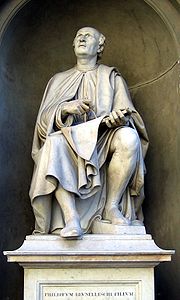Filippo Brunelleschi
From Wikipedia, the free encyclopedia.
Filippo Brunelleschi (1377 – April 15, 1446) was a great Florentine architect of the Italian Renaissance.
Contents |
Overview
Brunelleschi was trained as a sculptor in a Florentine workshop and was a member of the goldsmiths' guild. In the competition for the second set of doors for the Florentine Baptistry, he virtually tied with Ghiberti, who executed the famous "Doors of Paradise." He may have worked in Rome with his friend Donatello. His interests extended to mathematics and engineering and the study of ancient monuments. He made early experiments with perspective in painting, and invented hydraulic machinery and elaborate clockwork, none of which survives. Above all Brunelleschi is remembered as an architect who established new classic canons of serene rhythms, clear geometry, and symmetry, often using the simplest materials: gray pietra serena and whitewashed plaster.
His career centered from 1409 onwards on the construction of the Duomo, and especially on the famous problem of the "cupola", as the dome is generally called, which attracted his engineering bent.
Building the Dome
Brunelleschi's most famous masterpiece is the high, octagonal-ribbed dome of the Duomo (cathedral of Santa Maria del Fiore), the first notable dome erected in Italy since Antiquity. In 1418, a competition was announced for proposals on how to bridge the central crossing of the cathedral in Florence. Brunelleschi's bid was backed by a then less important family, the Medici, which would benefit hugely from the completion of the dome. His design, which offered to build the cupola in spiralling courses of brickwork forming two light shells, without a framework of scaffolding, won the competition, and in 1423 he was put in complete charge of the Duomo's building works. Its completion took most of his life. The main structure was finished by 1434 and then completed with Andrea del Verrocchio's lantern in 1436 and four half-domed tribunes in the apse in 1438. Its dedication took place on 25 March 1436, accompanied by a grand ceremony; music for the occasion, the motet Nuper rosarum flores, was written by Guillaume Dufay.
While construction was proceeding, Brunelleschi designed and built the Pazzi Chapel in the cloister of the church of Santa Croce, which was actually begun in 1442 after long negotiations. The chapel, where members of the Pazzi family were to be entombed, was meant to function as a chapter house for the Franciscans of Santa Croce. Brunelleschi's ribbed hemispherical dome is expressed on the exterior as a low tiled flattened conical roof on a low plain drum with small oculus windows. Inside, under the dome, the chapel is almost a cube, extended by barrel-vaulted bays on two sides. Pilasters and hemicyclic arches articulate the walls. The sedate materials are white stucco and the gray stone Florentines call pietra serena.
Other Details
Brunelleschi also built the Hospital of the Innocents (Spedale degli Innocenti, 1421-24, with glazed terracotta rondels by Andrea della Robbia and the Church of San Lorenzo, 1421-40). Through Brunelleschi, the architectural character of Florence was transformed.
When he died he was buried in Santa Maria del Fiore in a tomb so modest it was lost for centuries and only rediscovered in 1972.
His life was described in Giorgio Vasari's Vite.
Reference
- King, Ross (2001). Brunelleschi's Dome: How a Renaissance Genius Reinvented Architecture. Penguin USA. ISBN 0142000159
External links
- The Dome of Brunelleschi, Florence virtual reality movie and pictures
- Structure of the dome of Florence cathedral.
- Photos illustrate quotes from Vasari's biography of Brunelleschi.



